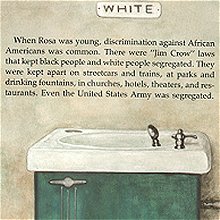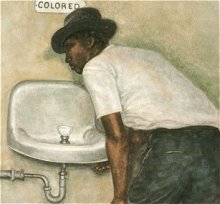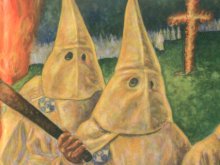
|

Soon after Rosa Parks was born in 1913, her family moved to Pine Level, Alabama. They
lived on Rosa's grandparents' small farm. In 1915, when Rosa was two years old, her brother
Sylvester was born. Soon after that their father left. He moved around to find work.
While Rosa was growing up, she hardly saw him.
As Rosa grew older, she worked on her grandparents' farm and in the nearby cotton fields.
In the spring she cleared weeds away and in the fall she picked cotton.
 When Rosa was young, discrimination against African Americans was common. There were 'Jim Crow' laws
that kept black people and white people segregated. They were kept apart on streetcars and
trains, at parks and drinking fountains, in churches, hotels, theaters, and restaurants.
Even the United States Army was segregated.
When Rosa was young, discrimination against African Americans was common. There were 'Jim Crow' laws
that kept black people and white people segregated. They were kept apart on streetcars and
trains, at parks and drinking fountains, in churches, hotels, theaters, and restaurants.
Even the United States Army was segregated.
 While Rosa lived in Pine Level, the Ku Klux Klan, a band of hate-filled whites, was active there.
They wore white robes and covered their faces with pointed hoods. In southern cities and elsewhere in the United States,
members of the Klan marched and helped elect political candidates who shared their hatred of African Americans, Roman
Catholics, Jews, and foreigners. They burned crosses and beat, tortured, and killed many blacks.
While Rosa lived in Pine Level, the Ku Klux Klan, a band of hate-filled whites, was active there.
They wore white robes and covered their faces with pointed hoods. In southern cities and elsewhere in the United States,
members of the Klan marched and helped elect political candidates who shared their hatred of African Americans, Roman
Catholics, Jews, and foreigners. They burned crosses and beat, tortured, and killed many blacks.
 Rosa's grandfather, Sylvesetr Edwards, carried a shotgun to protect his family from the Klan.
Rosa's grandfather, Sylvesetr Edwards, carried a shotgun to protect his family from the Klan.
School for black children in Pine Level stopped after sixth grade, so in 1924 Rosa continued her studies in
Montgomery, Alabama. Rosa finished high school in 1933.
In 1931 Rosa met Raymond Parks, a barber and a man active in the struggle for the rights of African
Americans. Rosa was proud that he spoke up for what was right. Rosa and Raymond were married in Dec. 1932 in her mother's
home in Pine Level.
In the early 1940s, Rosa joined the NAACP, the National Association for the Advancement of Colored
People, an organization that worked to end the unfair treatment of African Americans and
others. Soon after Rosa joined, she was elected secretary of the Montgomery branch of the association.
Buses in Montgomery were a daily reminder that the city was segregated. African Amnericans
were allowed only to sit in the back. On some buses they entered through the front door, paid
the fare, and were told to leave the bus and go in again through the back door. Sometimes, before they
could get on again, the driver drove away.
One day in 1943, Rosa got on the front of a crowded bus and paid the fare. The driver, James Blake,
told her to get off and use the back door. It was blocked by the many people standing there. But Rosa
got off. She didn't get on again. She waited for the next bus.
Twelve years later, on Thursday December 1, 1955, Rosa Parks met James Blake again. Rosa was coming home from her work as a
tailor's assistant at a Montgomery department store. She got on the Cleveland Avenue bus and took a
seat in the middle section. African Americans were allowed to sit in the back and in the
middle section, too, as long as no white passenger was left standing.
At the next stop, some white passengers got on, and, because the bus was crowded, moved to the middle section, where Rosa was sitting.
The driver told the four black passengers in Rosa's row to get up. Three of them did, but not Rosa
Parks. She had paid the same fare as the white passengers. She knew it was the law in Montgomery that she give up
her seat, but she also knew the law was unfair. James Blake called the police, and Rosa Parks was arrested.
On Monday, December 5, Rosa went to the local court and was found guilty of breaking the segregation
laws. She was fined ten dollars plus court costs. Rosa and her lawyers appealed to a higher court.
Beginning on December 5, to protest the arrest of Rosa Parks, African Americans in Montgomery refused to ride on
public buses. They found other ways to get to work. Many walked, some as far as twelve miles.
The bus boycott was led by Dr. Martin Luther King, Jr., the new minister at the Dexter Avenue Baptist Church.
On Monday evening, December 5, he spoke to a large crowd. He explained the reason for the
boycott. 'There comes a time,' he said, 'that people get tired. We are here this evening to say to those
who have mistreated us so long, that we are tired - tired of being segregated and humiliated,
tired of being kicked about by the brutal feet of oppression.'
The boycott lasted more than a year. During that time almost no African Americans rode a public
bus in Montgomery, Ala.
Rosa Parks, Dr. King, and many others were arrested. Homes of boycott leaders were bombed.
On November 13, 1956, the United States Supreme Court ruled that segregation on public buses
was against the law. On December 21, after the court order reached Montgomery, the boycott ended.
For some people, the civil rights movement in the United States - the fight for the rights of all
people to be treated as equals - began with the arrest of Rosa parks. For many it began one year
earlier. In May 1954, the Supreme Court had ruled that separate schools for blacks and whites
were unequal and against the law.
As there was still much discrimination against African Americans, Rosa Parks went to many
demonstrations and civil rights marches. She received threatening phone calls and her family worried about her
safety. In 1957 Rosa and Raymond left Montgomery with Rosa's mother and moved to Detroit, Michigan,
where Rosa's brother lived.
In 1965 Rosa began working in the Detroit office of a member of the United States House of
Representatives. There she did a lot of good work helping poor people to find homes. She retired
in 1988.
Rosa Parks has been called the 'Mother of the Civil Rights Movement'. The movement brought many
needed changes in the United States. It is now against the law for Americans to discriminate
against people because of their race, color, religion, or nationality, at work or in
restaurants, hotels, and other public places. The right of every citizen to vote is protected.
Rosa Parks has received many honors, among them the Spingarn Medal, the Martin Luther King, Jr., Nonviolent Peace
Prize, the Eleanor Roosevelt Woman of Courage Award, and the Presidential Medal of Freedom.
Cleveland Avenue in Montgomery was renamed Rosa Parks Boulevard.
If you want to buy the little book Dear Mrs. Parks - A Dialogue with Today's Youth second hand
in very good condition - (Lee&Low Books, paperback),
send me an eMail
The price of it is € 6 incl. postage.
|

 When Rosa was young, discrimination against African Americans was common. There were 'Jim Crow' laws
that kept black people and white people segregated. They were kept apart on streetcars and
trains, at parks and drinking fountains, in churches, hotels, theaters, and restaurants.
Even the United States Army was segregated.
When Rosa was young, discrimination against African Americans was common. There were 'Jim Crow' laws
that kept black people and white people segregated. They were kept apart on streetcars and
trains, at parks and drinking fountains, in churches, hotels, theaters, and restaurants.
Even the United States Army was segregated. While Rosa lived in Pine Level, the Ku Klux Klan, a band of hate-filled whites, was active there.
They wore white robes and covered their faces with pointed hoods. In southern cities and elsewhere in the United States,
members of the Klan marched and helped elect political candidates who shared their hatred of African Americans, Roman
Catholics, Jews, and foreigners. They burned crosses and beat, tortured, and killed many blacks.
While Rosa lived in Pine Level, the Ku Klux Klan, a band of hate-filled whites, was active there.
They wore white robes and covered their faces with pointed hoods. In southern cities and elsewhere in the United States,
members of the Klan marched and helped elect political candidates who shared their hatred of African Americans, Roman
Catholics, Jews, and foreigners. They burned crosses and beat, tortured, and killed many blacks.
 Rosa's grandfather, Sylvesetr Edwards, carried a shotgun to protect his family from the Klan.
Rosa's grandfather, Sylvesetr Edwards, carried a shotgun to protect his family from the Klan.